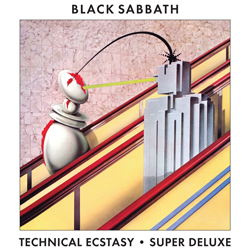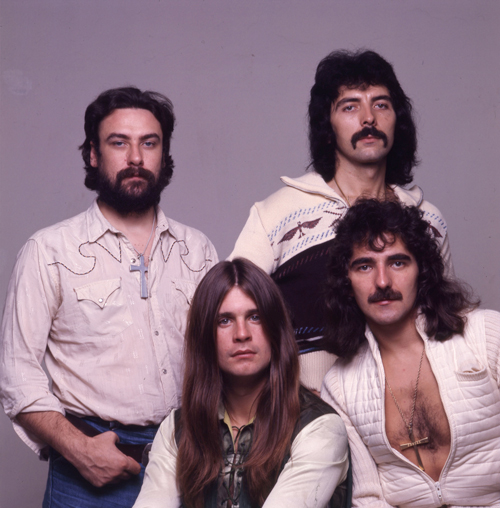 THIS WEEK I’M LISTENING TO...BLACK SABBATH Technical Ecstasy (BMG)
THIS WEEK I’M LISTENING TO...BLACK SABBATH Technical Ecstasy (BMG)
Beloved by some but berated by many, ‘Technical Ecstasy’ is not only generally considered to be the first of Black Sabbath’s two ‘also-ran’ albums, but also the start of a decline which would continue until the unveiling of ‘Heaven And Hell’ in 1980. Nothing could be further from the truth, though, and Sabbath’s seventh LP, released on 25 September 1976, is actually both underrated and under-appreciated. Although there’s no denying that it was their first release not to break into the UK Top 10, peaking at No.13, and that its assault on the US chart stalled at No.51, it’s still an exciting album to listen to today and one that boasts a clutch of extremely good songs.
Its recording came at what was a confusing time for rock music in general. Next door at Miami’s Criteria Studios complex The Eagles were recording ‘Hotel California’, while back at home punk was beginning to make itself felt; a month after ‘Technical Ecstasy’ appeared in the shops The Damned’s ‘New Rose’ single was released, followed in November by ‘Anarchy In The UK’ and, shortly after that, the sweary Sex Pistols appeared on Bill Grundy’s TV show and punk went nationwide. Critics began to question the ‘relevance’ of bands like Black Sabbath, and it certainly didn’t help either that, as Ozzy Osbourne admits in his autobiography ‘I Am Ozzy’, “I’d started to lose interest, and I kept thinking what it would be like to have a solo career.”

photo credit: Sam Emerson
Against this backdrop ‘Technical Ecstasy’ struggled to make itself heard. And it is a mixed bag, to be fair - ‘Paranoid’ it certainly is not. The original album was produced by Tony Iommi (although there's a band credit on the sleeve) but as Iommi points out in his autobiography ‘Iron Man’ “again, I was in the studio full-time, being very much involved in the production... Everyone else was always on the beach...”, and the original mix hasn’t really held up over time. There were two ballads, this time around: the heavily orchestrated ‘She’s Gone’, later to pop up on the B-side of ‘Never Say Die!’, is a heartfelt piece and certainly better than ‘Changes’, while Bill Ward’s ‘It’s Alright’ seems to want to plant itself in John Lennon’s garden, although does raise the tone somewhat after the downbeat – and magnificent – ‘You Won’t Change Me’ with its demonic opening progression. Then there’s ‘Rock ‘N’ Roll Doctor’, a quite simplistic piece which appears to take a leaf from the early poptastic KISS songbook, despite being an obvious reference to one of the band’s many dealers. At the end of the album, ‘Dirty Women’ gives Tony Iommi a chance to show off (and was the only cut from the album to make the setlist for the band’s 1997 reformation shows), LP side openers ‘Back Street Kids’ and ‘All Moving Parts (Stand Still)’ are Sabbath to the core, and ‘Gypsy’ is one of the band’s great unacknowledged gems. OK, so Old Nick didn’t feature in the lyrics any more but bands need to progress, and had Sabbath just endlessly rehashed the diabolic leanings of the early albums they would soon have dropped out of favour anyway.
Then there was the artwork. The band commissioned Hipgnosis for an eye-catching cover (and associated tie-ins), and although the studio did wonders for Pink Floyd amongst many others they maybe weren’t the right agency for Sabbath: on the plus side, this time around you didn’t get to see Bill Ward’s underpants, but as Osbourne noted in his memoirs: “one minute you had an album cover like ‘Sabbath Bloody Sabbath’...and the next you had two robots having sex while they’re going up a fucking escalator...”

Yet whatever its reception at the time, ‘Technical Ecstasy’ is certainly worthy of the deluxe revamp treatment, joining ‘Paranoid’, ‘Vol.4’ and ‘Sabotage’ in the racks as a five LP or four CD box set. You’re probably familiar with the format by now but, if not, what you get this time around is a new remaster of the original album, an eight-track disc or LP of outtakes and alternate mixes, a fabulous completely new mix of the album by Steven Wilson, and a final CD or double album of live material from the 1976/77 world tour. In addition, the set includes a booklet, replica tour programme and poster.
The Steven Wilson mix is definitely worth having, as it reboots the album beautifully without intruding on the record’s original ambience. The live disc – an hour’s worth of material – kicks off with ‘Symptom Of The Universe’ (following a snatch of intro tape ‘Supertzar’) and then romps through ‘War Pigs’, ‘Gypsy’, ‘Black Sabbath’, ‘All Moving Parts (Stand Still)’, ‘Dirty Women’, ‘Drum Solo’/‘Guitar Solo’ / ‘Electric Funeral’ / ‘Snowblind’ and ‘Children Of the Grave’. Unfortunately it’s a pick ‘n’ mix from various shows on the tour (there’s no record of ‘War Pigs’ appearing second in the set on any night, for example) which kicked off in the States in October 1976 and then moved to the UK the following March before dates in Europe brought things to a close – the penultimate night, in Sweden, being heavily bootlegged as ‘Live At Lund’. Despite the fact that behind-the-scenes chaos and dysfunction now appeared to be the day-to-day norm in the Sabbath camp, the live material demonstrates that once on stage Osbourne, Iommi, Butler and Ward could still put on a show, and the new material – ‘Gypsy’ in particular – is absolutely stunning.
A worthy addition to any collection, and a timely rehabilitation of one of Black Sabbath’s long-overlooked classics.
© John Tucker September 2021
